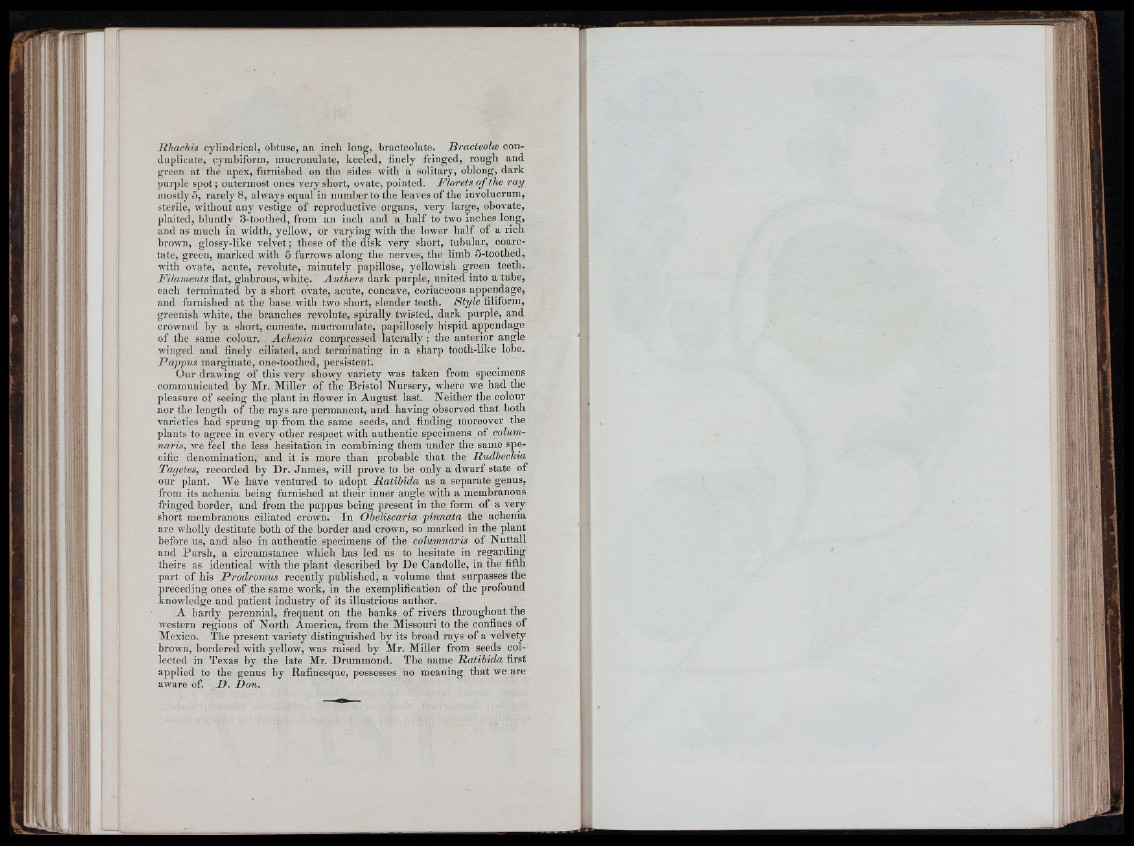
lihacMs cylindrical, obtuse, an inch long, bracteolate. Bracteolw con-
duplicate, cymbiforni, mucronulate, keeled, finely fringed, rough and
green at the apex, furnished on the sides with a solitary, oblong, dark
purjde spot; outermost ones very short, ovate, pointed. Florets o f the ray
mostly 6, rarely 8, always equal in number to the leaves of the involucrum,
sterile, without any vestige of reproductive organs, very large, obovate,
plaited, bluntly 3-toothed, from an inch and a h a lf to two inches long,
and as much in width, yellow, or varying with the lower half of a rich
brown, glossy-like velvet; those of the disk very short, tubular, coarc-
tate, green, marked with 5 furrows along the nerves, the limb 5-toothed,
with ovate, acute, revolute, minutely papillose, yellowish green teeth.
Filaments flat, glabrous, white. Anthers dark purple, united into a tube,
each terminated by a short ovate, acute, concave, coriaceous appendage,
and furnished at the base with two short, slender teeth. S tyle filiform,
greenish white, the branches revolute, spirally twisted, dark purple, and
crowned by a short, cuneate, mucronulate, papillosely hispid appendage
of the same colour. Achenia compressed late ra lly ; the anterior angle
winged and finely ciliated, and terminating in a sharp tooth-like lobe.
Pappus marginate, one-toothed, persistent.
Our drawing of this very sliowy variety was taken from specimens
communicated by Mr. Miller of the Bristol Nursery, where we had the
pleasure of seeing the plant in flower in August last. Neither the colour
nor the length of the rays are permanent, and having observed that both
varieties had sprung up from the same seeds, and finding moreover the
plants to agree in every other respect with authentic specimens of columnaris,
we feel the less hesitation in combining them under the same specific
denomination, and it is more than probable that the Rudbechia
Tagetes, recorded by Dr. James, will prove to be only a dwarf state of
our plant. We have ventured to adopt Ratibida as a separate genus,
from its achenia being furnished at their inner angle with a membranous
fringed border, and from the pappus being present in the form of a very
shorl membranous ciliated crown. In Obeliscaria pinnata the achenia
are wholly destitute both of the border and crown, so marked in the plant
before us, and also in authentic specimens of the columnaris of Nuttall
and Pursh, a circumstance which has led us to hesitate in regarding
theirs as identical with the plant described by De Candolle, in the fifth
part of his Prodromus recently published, a volume that surpasses the
preceding ones of the same work, in the exemplification of the profound
inowledge and patient industry of its illustrious author.
A hardy perennial, frequent on the banks of rivers throughout the
western regions of North America, from the Missouri to the confines of
Mexico. The present variety distinguished by its broad rays of a velvety
brown, bordered with yellow, was raised by Mr. Miller from seeds collected
in Texas by the late Mr. Drummond. The name Ratibida first
applied to the genus by Rafinesque, possesses no meaning that we are
aware of. P . Don.